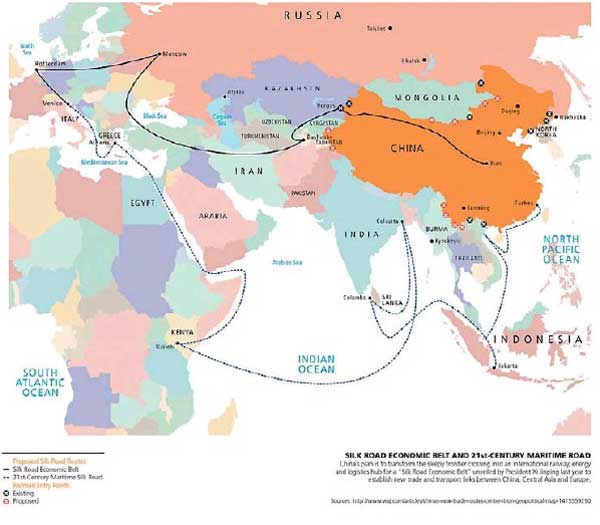Reply To:
Name - Reply Comment
By: Ramla Wahab & Nishant Gooneratne
“Whoever controls the Indian Ocean dominates Asia. This ocean is key to the seven seas. In the twenty-first century, the destiny of the world will be decided on its waters”.Alfred Mahan (US Navy admiral, geo-strategist)
The Indian Ocean Region (IOR) contains 40 percent of the world’s oil and gas reserves, a third of the world’s population and plays host to key Sea Lines of Communication (SLOC).
It has traditionally stood as the gateway to Africa, Europe and the Pacific. In the theatre of the Indian Ocean Region (IOR), since 2013, it is these key regions that the 21st Century Maritime Silk Road (MSR) initiative seeks to connect Vis-a Vis greater regional economic cooperation.
First to offer unconditional support
Sri Lanka at the centre of global co-operation and rivalry in the Indian Ocean was among the first nations to offer unconditional support for the 21st Century Maritime Silk Road (MSR) Initiative in 2014.
The island is geographically positioned strategic to the project’s success in ambitions of connectivity. Changes in Lankan leadership have precipitated a shift from a China centric foreign policy towards a multilateral outlook.
The Booze Hamilton Allen inspired String of Pearls theory of Chinese military advancement, proposed a decade ago, has lost credibility.
Evidence points to the contrary that China’s enhancing role in the Indian Ocean region is not military but economic in nature.
China ready for talks
China presents itself to be willing to discussion and transparency in its projects in the island .This was expressed by Liu Jian Chao (Chinese Assistant Minister of Foreign Affairs) on his special visit to Sri-Lanka to re-affirm positive Sino-Sri Lankan ties in the wake of political transition.
This reorientation of Sri Lankan foreign policy since January of 2015 championing transparency in investment projects, tempers the MSR project to promote increased transparency throwing open its previously unknown manner of unimpeded progress.
The Pacific Forum of 2014, in an analysis applicable to the IOR expressed that Chinese infrastructure projects can be characterised as being domestic economic stimuli for China with much of the labour and materials being Chinese.
This process, they concluded, leads to a repatriation of the Investment Capital. Guarantees must be obtained with regard to the application of a consistent policy on MSR. Such promises must guarantee irrevocability of policies after the completion of the 100 days program and upcoming general election. The MSR initiative in its totality remains weakened by political vicissitudes and posture adopted by the new coalition government.
The core of the MSR arm of Chinese foreign policy lies in creating and maintaining mutually beneficial cooperation and friendly trade and cultural relations with countries along the maritime route of old through its One Belt One Road policy. Sri Lanka, prior to the regime change was in a position not only to contribute to the development of the MSR but also to be a vital cog in the efficient functioning of this historic venture due to its key geostrategic placement.
The infrastructure projects including the planned Colombo port city were the subject of much vacillation on the part of the incumbent regime, which has announced the re-evaluation of the projects subject to economic, environmental feasibility and impact assessments. While this issue has created a degree of uncertainty and anxiety regarding the projects, it has not been entirely detrimental to the Sino-Sri Lankan relationship which remains a “time tested and time honoured” bond according to Chinese Presidential special envoy Liu Jianchao.
Window of opportunity
Despite the disruption to the momentum generated by the previous regime in instituting MSR projects, President Maithripala Sirisena’s government has a window of opportunity to mend strained relations with the West.
While doing so, it could maintain the benefits obtained through projects of regional connectivity such as the MSR.This could be achieved by proposing the continuance of such projects, subject to an in-depth look into numerous issues of transparency and charges of corruption that have plagued law makers in the previous regime. Such development projects are mutually beneficial to both Sri Lanka and China as it would greatly increase maritime connectivity, and build the infrastructure that is required to sustain the rise of the Asian century by 2050.
ADB estimate
The Asian Development Bank (ADB) has estimated that demand for infrastructure investment stands at US $730 billion a year for the next decade.
India considered in isolation, requires $1 trillion of investment over the next five years. The Chinese economic model has been credited with spurring rapid and sustained growth, thanks in large part to its heavy accent upon infrastructure development. In contrast, India’s deficient infrastructure network has imposed a 150-200 basis point loss of annual economic growth, which has adversely affected GDP growth and manufacturing competitiveness.
Sri Lanka has also suffered in terms of competitiveness due to a lack of infrastructure, which should provide the impetus to take advantage of the soft power projection that is the MSR venture as well as programs built into the AIIB (Asian Infrastructure Investment Bank). The AIIB has been seeded with $50 billion of capital in addition to the $40 billion pledged to the Silk Road Fund.Shapers of Sri Lanka’s maritime policy have much to consider with the island being a traditional point of connectivity to the wider world.
